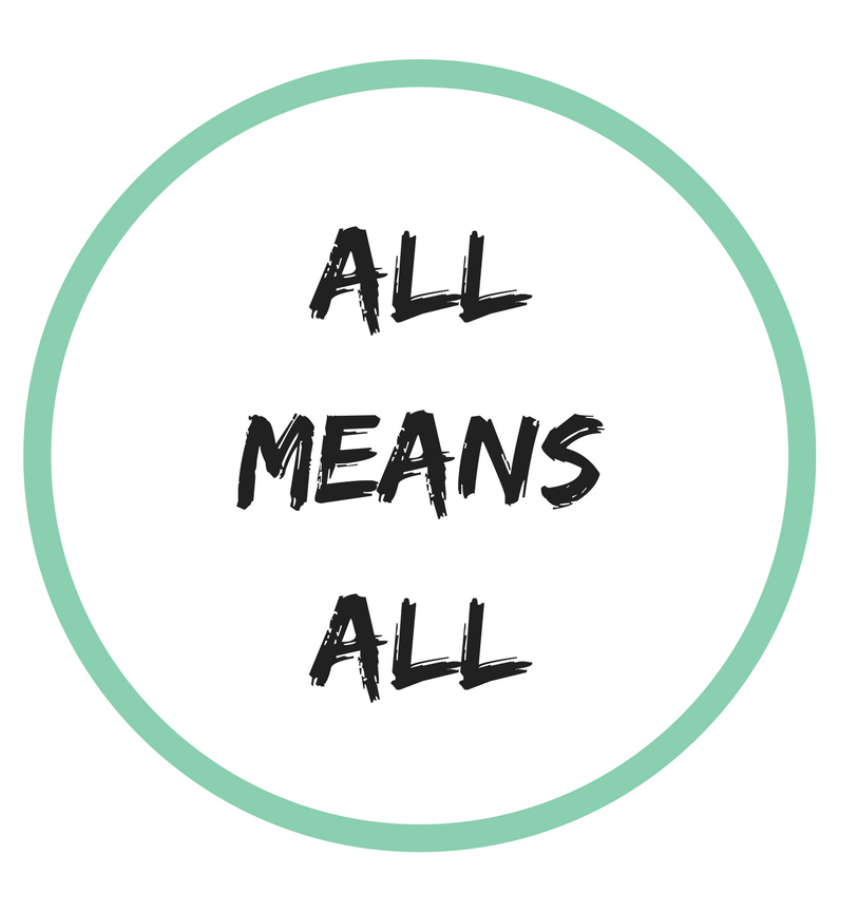Sometimes the waves of life overcome the sensibilities of patience, kindness, temperance, optimism and compassion. In a new year quiet moment standing by the majesty of the Northeast Atlantic as she reigned her fierce power, sprayed with her salty mist and pulled my breath away with her powerful blasts, I was reminded of the forces greater than mere mortal ways which demand much of our waking energy. The proverbial “we” struggle with controlling the surf, searching for the ethereal place of balance forgetting that we don’t get to control the crashing surf of greater humanities. The only thing we can really control is ourselves, our thought lines, our actions and our commitments to better our world. As I move through the first months of the new year and the noisy social debris of a politically tumultuous time, I find myself sorting through the flotsam and surfacing with a collection of new thought lines to carry forth. This spin will take a technical "all means all" journey through the turbulent inclusive waters of the past, anchor educational commitments in the present and chart a course toward greater equity for the future.
Overseas in the late 1990s, I was teaching in a small community alternative school learning how to educate children with varied neurological profiles. I wrote about this experience in Living in the Limbic as I zoomed into the importance of thinking differently about human behaviour and how educators need to better understand the impact of stress, the interbrain and the limbic system on the learning process. Little did I know that during my time at The Mead School anchor points for my life and career were being positioned. The educators and the children that I had the privilege of working with and teaching come to my mind often when I think about the critical importance of educational design for all. This experience set the course for my career and inspired my doctoral research on designing for inclusivity in the secondary school context. While there were so many personal and professional lessons during my time at The Mead, one conversation haunts me and continues to push me to do better for all students. A forever unnamed individual asked me one evening why was I "wasting my time and potential with those students." It was painful to learn how he viewed the world and his disregard for children with unique needs as he dismissed their place in humanity. Our relationship ended in that moment, yet that conversation lingers like a persistent undertow and reminder of the cruelty that some humans hold. Counteracting that undertow is my commitment to greater equity for all children and youth, to encourage the rip currents of transformation as we work towards creating an educational system where all means all.

Intentionally redesigning inclusive education requires innovative adults who care deeply about children and who are willing to think differently about what inclusion means in today's classroom. A common misunderstanding of inclusive education practices is that the end goal is for full participation for all students in the mainstream classroom. While increasing active engagement and supporting connections with same age peers are important aspects of the school experience for all students, the reality is that some students will need more unique, individualized educational designs to support their healthy growth and development. The creation of an individual educational plan (IEP) is a formalized structure in Canadian schools, created to establish meaningful, strategic pathways for learning for individual students with exceptionalities. Students are eligible for IEPs based on school districts formalized designation processes related to unique learning profiles, diverse abilities and/or disabilities. All public school districts in Canada have accountability structures that regularly review student designations and IEP creation to ensure processes and procedures are clearly aligned with provincial educational structures and resources.
Five years ago, in a stormy doctoral post, Poking the Bear, I shared my frustrations with the IEP development and implementation. Half a decade later I am still sparked when I read IEPs that surpass my 2-3 goal threshold, lack student voice or choice. IEP case managers need to ask themselves, "Do I remember each goal?" If not, then charting the course of impactful learning and strategic support for individual students will be fraught with challenges. Learning goals should be changing as students grow in our educational care. Goal setting should focus on prioritizing which skill is most important to achieve at this moment in time in order to progress to the next stage of learning. The sequential process of goal setting is one of strategic backward design where we break down the acquisition of learning intentionally based on student needs and wishes. Student voice and choice, alongside of meaningful consultation, and collaborative IEP development are also critical features of effective individualized learning plans. When I discover that meaningful consultation with parents and guardians has been light, I am saddened by how these important planning tools are too frequently misconstrued as reporting documents falling under the umbrella of school accountabilities rather than impactful educational design. Parents, guardians, classroom teachers and case managers need to work collaboratively to create high quality IEPs. Quality matters and discovering learning barriers requires many caring, knowledgable and inquisitive minds. I appreciate the technical language and clear direction in the new BC Ministry of Education and Child Care Inclusive Education Services manual which outlines 7 clear steps in IEP development. To chart the course from a practitioner's perspective, I would encourage inclusive educators to also consider the following 5 impact points when creating meaningful IEPs.
IEP Impact Point #1: Environment is Everything
A good IEP centres the student at the centre of all planning. This includes the physical design of learning environment. Beware of one size fits all designs and antiquated practices of trying to slot square pegs into round holes. A good IEP centres the way in which the environment can be adjusted and adapted to meet the student’s individualized needs (Pendharkar, 2023). A good IEP also expands environmental designs to include the humans who habitate those spaces. On the fly or happenstance set up of learning situations can be detrimental to the growth and development of students who may need additional time or softened conditions to adjust to the presence of other students. While teachable moments can be valuable, our job when creating meaningful IEPs is to design learning environments where the many macro and micro design details have been thougthfully considered. Pushing humans into spaces that cause additional and undue stress are practices that can cause further harm and trauma to their lived experiences. Thinking differently about optimal learning conditions and creating learning spaces where students feel safe and secure with a little bit of what I call "the stretch factor" are part of impactful IEP designs. Here are 5 tips for consideration when exploring the relationship between environmental design, a student's learning preferences and essential supports.
- Flexibility
- How flexible can we be when it comes to designing so that our learning environments can evolve and shape shift to meet individual student needs?
- Is there room for movement and choice in the environmental designs? Are we thinking in silos about our school environments (e.g. my classroom, your classroom) or are we collectively collaborating to think about unique ways to design learning spaces for all children?
- Are we thinking about how we can use space to nurturing healthy human interactions and supportive learning relationships? Are we sensitive to the other individuals in learning spaces? Are we brave enough to honestly consider what, and who, may be helpful or hurtful to the student's growth and development?
- Accessibility
- How open is the learning environment for physical movement?
- Have we ensured that indoor and outdoor learning spaces are meeting mobility and accessibility codes for all individuals?
- Have we physically sat in the space(s) where students sit so that we can experience their actual view points?
- Organization
- Is the learning environment organized and clear of clutter which may confuse and distract some students more than others?
- Have we established systems and structures where learning materials are positioned so that students can easily find what they need (e.g. labeled materials, colour coded systems and visual schedules, etc.)?
- Where does our adult material live in the learning environment? Have we considered who the space is primarily for and how we will coexist in the space?
- Sensory
- How aware are we of our students' sensory needs? Have we asked students or their families about sensory preferences?
- How much do we know about sensory learning designs and their impact on student participation?
- Are there quiet recovery nooks in all of our learning spaces where students know they can tap out and cognitively recoup when they need a little escape?
- Technology
- How are we integrating AI technology such as screen readers, speech-to-text software communication devices as easy access, no questions asked tools in our learning environments?
- Do we have designated low tech and high tech zones in our learning environments where students needing assistance with regulating technology usage can physically separate in a positive, supportive manner?
- How can we reduce barriers to ensure that technology is always readily available to students needing it (e.g. loaner devices, charging stations, tech inventories and maintenance, reliable internet, tech training for staff, etc.)?
IEP Impact Point #2: The Stretch Factor
For my fashion friends, you will know that the stretch factor is all about how far a fabric stretches past it's relaxed state. Stretch factor is important because it plays an important role in how the finished garment will sit on the body. How we feel in our own skin (or clothes) matters and is essential in the IEP creation process. How things hang can positively or negatively shape the learning journey ahead. Individual voice and choice is critical. We need to understand student preferences, interests, and strengths alongside of their healthy stretches and "no thank you" points. Just as each fabric has its own stretch factor, every individual has preferences and aversions. While we can't assume that one size ever fits all, we have to find safe ways to help students go beyond their current capacities to promote growth, creativity and individual choice. All students deserve educational excellence and the best that our school systems have to give. IEPs should focus on high, yet achievable, expectations while integrating real-world connections with open ended challenges. Ensuring that all IEPs include the use of digital tools and technology as ways to leverage exploration, to stretch growth and enhance collaboration are indispensable aspects of impactful, modern educational planning. If all means all, then we have to establish systems and structures to help every student experience the stretch factor in our classrooms.

IEP Impact Point #3: Continuous Communication & Coordination
Communication is the most important skill to be developed for many students with learning differences or disabilities. Scratch that communication is the most important skill to be learned by all students and adults. Learning how to express needs and desires are essential skills in building healthy human relationships. Communication is an educational foundation that too frequently surfaces as a learning focus after incidents of communication breakdown occur. How we intentionally coordinate and position communication as a priority in educational planning for all students is essential. How we model respectful and appropriate communication as educators is critical. Our self awareness of how we communicate sets the course for learning designs that are relationally safe and secure for youth. From an IEP perspective, impactful communication asks educators to deeply consider communication strategies, styles and synergies.
- The choice of words and tone of communication matters. How truly thoughtful are we when it comes to the deliberate and careful selection of the words we use to deliver messages? Our ability to be introspective and compassionate can help a conversation soar. Our inability to recognize the power of the words we choose and use can run the edge of creating unnecessary confusion, stress and potential heartache. Nurturing our capacity to slow down and to gift ourselves time to thoughtfully construct responses and to think more intentionally about the words we choose, and the words we use is essential. When reporting on IEP progress these capacities are pivotal in establishing collaborative, coordinated communication between all parties. Sensitive, honest conversations demand thoughtful, compassionate and skilled educators. Supporting professional growth and learning related to enhancing communication practices is always a solid investment for school systems.
- The timing, space and place of communication matters. Have we considered the timing of our communication and how it may be received by another? This is particularly important when the feedback or message itself may be of a difficult nature. Friday night emails or dropping concerns in the parking lot at student drop off or pick up are rarely communication wins. Beware of keyboard warriors who load up emails with sensitive information and concerns. When in doubt, pick up the phone and talk human-to-human. Think about how IEP meetings are structured and the delicate balance between not enough time and perhaps too much time. Facilitating an IEP meeting to ensure the just right time is allotted for communicating throughly and thoughtfully requires case managers to prioritize and to build a schedule that allows for more time based on conversational complexity. Educational leaders can support this process by ensuring that IEP meetings and the "asks" on case managers during these times are balanced and mindful of the complexity of the work.
IEP Impact Point #4: Back to the Future
At the risk of dating myself, I'm going to connect Marty McFly and his time-travelling DeLorean to impactful IEP development and future thinking. The entire premise of the 1985 sci-fi classic "Back to the Future" follows 15-year old Marty McFly and his accidental trip back in time to 1955. Marty's actions in the past relate to his future life when he meets his parents and begins an adventure in time that runs the risk of impacting life to come. I appreciated Marty and Doc Brown's ability to look forward and backwards to figure out where they needed to go. Here lies my stretch connection to developing impactful IEPs. When we are creating goals and objectives we have to hold the future at the centre of IEP creation. While there is always the immediate importance of right now, I see too many IEPs that fail to line up tomorrow's opportunities. Creating pathways towards successful adult lives requires investing time today in skill development and experiential learning. I struggle with understanding why things like student work experiences, paid and unpaid, land within the final years of a student's school experience. When we wait too long for experiential learning we don't have enough road to get to where we need to go. Unlike McFly and Brown's adventures, many of our students need actual time on the road with well written IEPs effectively mapping out key sights to stop and see. Navigation tools such as person centred planning experiences like the PATH (Planning Alternative Tomorrows with Hope) and supported employment opportunities can help us create pathways towards all meaning all. These long-term perspectives and educational strategies can help students, educators, and families struggling with the immediate see hope, and the future, beyond today's challenges.

Marty McFly: Hey, Doc, we better back up. We don't have enough road to get up to 88. Doc Brown: Roads? Where we are going we don't need roads.
Back to the Future, 1985
IEP Impact Point #5: All Means All
I want to close with emphasizing that impactful IEPs are not reporting documents. The crashing, demanding waves of accountability and funding structures too frequently push school systems into the whirlpool of positioning IEPs as life rafts. This is a dangerous practice which overloads systems and dehumanizes the potential of IEP development. Too many schools run the risk of getting tangled in the net of fishing for IEPs. This net is a dangerous one, fuelled with fallacies about IEPs as ways to generate increased supplemental funding. We need to continue to shift our thinking away from the security of an IEP and press into outlining and committing to impactful educational programming with the individual student at the centre. I appreciate the ongoing research of educators like Caitlin Tucker, Shelley Moore, and Katie Novak, whose focus on competency based educational planning for neurodivergent learners is elevating educational design and improving school-based practices.
While some may argue with the social construct of equity, through an educational lens the opportunities afforded to youth are critical for tomorrow's world. In a time of rough geopolitical waters how we create meaningful learning experiences in our Canadian public schools matters more than ever before. Every child and youth deserves the best that our school systems can possibly offer. Designing for educational excellence and anchoring all means all means we create new, innovative and individualized ways to do better for every student. Staying afloat is not the end game, learning how to navigate the uncharted waters of change and creating the educational conditions for all students to thrive and flourish in our classrooms is. All means all is not just a social nicety, it is the anchor to our work in schools as we honour every student's unlimited potential.



